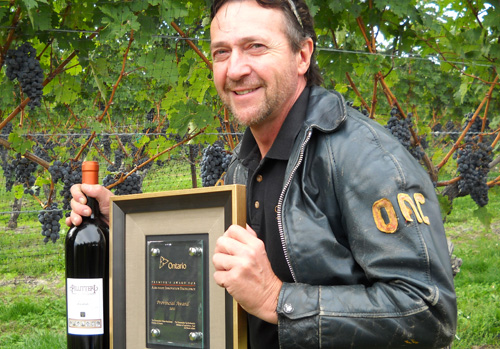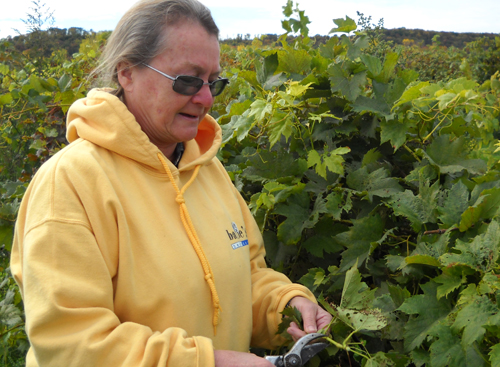
The first-ever commercial use of a novel grapevine grafting method by a U of G researcher has won an agri-food innovation award this year for a Niagara winery and taken the company a step closer to creating a home-grown version of a prized Italian wine.
Guelph graduate Jamie Slingerland, director of viticulture at Pillitteri Estates Winery in Niagara-on-the-Lake, received the award this fall. The award recognized a project using green shoot grafting to develop three new grape varieties in Canada through research, certification and commercialization.
The company now plans to produce the first wine made in Canada from Amarone grape varieties native to northern Italy.
Under a four-year contract research project funded by the winery, plant agriculture professor Helen Fisher showed green shoot grafts can develop new vines more rapidly from less plant material than traditional grafting from dormant vines.
“You get many more plants per mother plant, so you get faster propagation,” says Fisher, a Guelph grad who retired in 2011. She was based at U of G’s former research station in Vineland, Ont.

The technique also allows for faster vine growth. Normal grafting of rootstock and desired grape varieties called scions involves cuttings of dormant hardwood. It takes several years of growth before vines are ready for hardwood cuttings.
Green shoot grafting allows propagation of shoots in their first year. Those shoots are more fragile, says Fisher, who experimented with methods and tools before settling on a technique that worked.
Green shoot grafting is more expensive than conventional grafting. But a grower can take numerous cuttings throughout the growing season rather than once with dormant wood.
Grafting is needed to prevent the spread of viruses in scions and to protect roots from soil pests.
Faster propagation means more vines in the ground earlier and less time for a winery to grow grapes and introduce new products, says Slingerland, ADA ’79.
The first GSG vines were planted in 2010. Earlier this fall, he was preparing to harvest the first crop, grown on part of Pillitteri’s roughly 100 acres of vineyards.
That crop will become either ice wine – perhaps as soon as next year – or table wine to be bottled by 2015. Ice wine makes up about half of the company’s products, and much of it is sold abroad, particularly in Asian countries, says Slingerland.
“As an industry, we’re using whatever technology we can find to produce a better product. We have to be innovative.”
Pillitteri’s Verona Appassimento project is intended to produce the first Ontario Appassimento (rack-dried) wine from Amarone grape varieties. All three varieties – Corvina, Rondinella and Molinara – are native to an area of northern Italy known for its wine production.
The wine has strong flavours and relatively high alcohol content, says Slingerland. “From a wine lover’s perspective, it’s intense wine.”
Gary and Lena Pillitteri began their winery in 1993, almost three decades after buying a fruit farm in Niagara-on-the-Lake. Gary had grown up in Sicily before coming to Canada at age 12.
After completing his horticulture diploma at Guelph, Slingerland worked for several years for the Ontario Ministry of Agriculture, Food and Rural Affairs (OMAFRA). He married Connie Pilliterri, one of three children of the winery founders and the company’s operations president.
Continuing the family connection, Jamie’s brother, Kenneth, ADA ‘75, was Ontario’s tender fruit and grape specialist for OMAFRA in Vineland before retiring in 2011. Kenneth’s wife, Janice, completed a B.Sc. at Guelph in 1980.
Green shoot grafting is used in other parts of the world, normally in climates with longer growing seasons. In the Niagara Peninsula, growers need controlled greenhouse conditions and plant material free of pests. Virus-certified plant material for the project came from the University of California at Davis, the only source of this material in the world.
Slingerland had approached Fisher to help with the project. For two decades, she had worked on grapevine physiology and breeding at the Vineland research station run by OMAFRA; she joined U of G in 1996.
Also involved in this project was Wayne Brown, a Guelph grad and a specialist in greenhouse ornamental production at OMAFRA in Vineland.